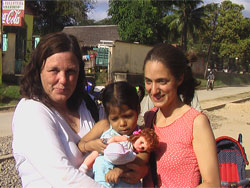In Bolivia, Helping Children to See and Be Heard
Visiting TC students navigate cultural differences to provide speech/language pathology services
In Bolivia, little kids spend a lot of time experiencing the world from the vantage point of an awayo-a sling worn over their parents' backs. Depending on a parent's particular style, a kid might get bundled in near the top of the awayo, meaning the view will be good and conversation frequent-or near the bottom, where things tend to be quieter and darker.
For a child who's blind, the two scenarios can have radically different consequences. And because blind children are more likely to get carried by their parents until an older age, those consequences can be profound.
"I told a mother of one blind girl, You are her eyes,'" says Cate Crowley, a lecturer in TC's Speech and Language Pathology program and head of its Bilingual Extension Institute, which seeks to improve quality of care for culturally and linguistically diverse children and adolescents. "That's intervening on a cultural level, which normally we wouldn't do. But a blind child who spends a lot of time being carried deep in the awayo doesn't get the chance to learn from siblings and peers the way typically-developing kids do. In Bolivia there's a cultural belief that children should be seen and not heard. Kids without disabilities develop perfectly well in Bolivia but that belief can have serious implications for a child with a disability. So it's really important to educate parents about the consequences."
The awayo problem is typical of the challenges faced by the small groups of TC students Crowley has taken on month-long trips to Bolivia during each of the last two summers. This past July, 18 students worked at three different sites, earning course credits in the process. At the Hospital Del Ninos, Bolivia's national pediatric hospital in La Paz, students worked with children in the acute care wards and with parents of babies and toddlers who were failing to thrive, showing them feeding therapy and early intervention stimulation techniques such as cooing, eye-contact and touching. At Camino de Sordos, a signing-based school for deaf children, they worked on reading skills often using a multi-sensory approach to improve phonemic awareness. And at Foundacion CEREFE (translated as the Center for Physical Rehabilitation and Special Education) in El Alto, they worked with children and teenagers with a range of disabilities, from Down's syndrome to swallowing disorders.
Prior to making the trip, the students were required to extensively research the causes, prevention, identification and treatment of a particular speech/language-related disability and prepare a PowerPoint presentation that they later delivered-in Spanish-to audiences of Bolivian doctors, teachers, parents, nutritionists and public health officials. They also received free Spanish lessons twice a week. Once in Bolivia, the students used their field placements both to deliver care and health education, and to assess the current state of knowledge and practice on the disability they have chosen.
The ultimate goals-borrowed from the Peace Corps philosophy-are to "be respectful of our hosts' culture and make the program self-sustaining for them," says Crowley, also a former attorney who still advises New York State on disability issues.
"It's an incredibly valuable, life-changing experience for our students, particularly given the growing Hispanic population in the U.S.," she says, adding that she first visited Bolivia when her daughter's best friend moved there a few summers ago. "The biggest challenge we've faced so far is creating good placements for the monolingual English-speaking students who come on the trip. We've got to balance their needs with our obligation to provide Bolivian kids with quality care."
Crowley says that an arrangement with TC's Center for Educational Outreach and Innovation (CEO&I) has enabled her to hold down costs for students. She also credits John Saxman, Chairman of TC's Biobehavioral Sciences Department and a visitor in Bolivia this summer, with supporting her vision for the program.
The students were well-received by the Bolivian medical community, Crowley says, but the most rewarding feedback was from parents:
"One of the mothers said to one of our students, you taught my son how to speak.' She had tears in her eyes."
An article by Crowley on the Bolivia program will appear in mid-October in The Leader (www.asha.org/about/publications/leader-online/), the publication of the American Speech Language Hearing Association. Crowley also is the recipient of the Association's 2007 award for Special Contributions to Multicultural Affairs.
http://www.sordociegos-multis.org/cerefe/solotexto/inicio.htm
Published Thursday, Oct. 18, 2007
